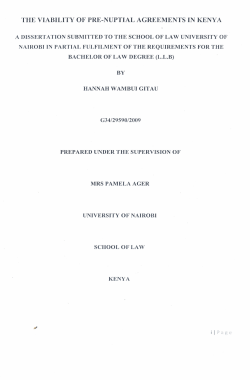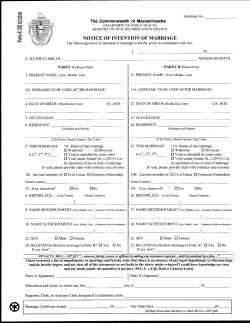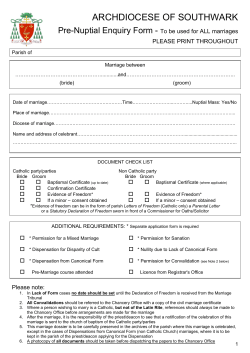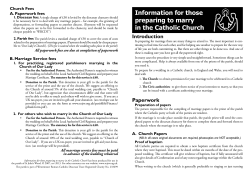
THE SUPREME COURT OF CANADA’S DECISION IN HARTSHORNE:
THE SUPREME COURT OF CANADA’S DECISION IN HARTSHORNE: Implications for the Family Law Practitioner By Alfred A. Mamo (These speaking notes are an outline for a paper which is under construction. The author apologizes for the fact that the final product is not available at this time, however, these notes should still be of use to the participants for the purpose of generating discussion.) SPEAKING NOTES: PART I: WHAT’S THE FUSS ALL ABOUT? The Facts: The parties began living together in 1985. Both parties were lawyers, with the wife working at the husband’s firm. The parties had their first child in 1987. The wife left employment on maternity leave and remained at home as the full-time care giver. When the parties married in 1989 (a second marriage for both), the husband had assets valued at approximately $1.6M. The wife on the date of marriage had no assets and was in debt. The husband arranged for a Marriage Contract, which stipulated that the parties would be separate as to property but that the wife would be entitled to 3% in the family home for each year the parties were married up to a maximum of 49%. The parties obtained independent legal advice prior to signing and the wife was advised by her lawyer that the Contract was unfair. The parties signed the Contract on their wedding day after a few amendments which included the preservation of the wife’s right to claim spousal support. The parties had a second child later in 1989. The parties separated in 1998 and divorced in 1999. The parties resided in British Columbia. When the marriage ended, the husband’s net worth was $1.2M, while the wife would receive $280,000.00 under the terms of Contract. The Supreme Court of Canada’s Decision: The Majority Opinion: The wife alleged that the Contract was “unfair” within the meaning of Section 65 (1) of the Family Relations Act of British Columbia and requested that the Court re-apportion the family assets to achieve a “fair” distribution. The Trial Judge decided that the Contract was unfair and re-apportioned most of the family assets 60/40 in husband’s favour but divided the matrimonial home and contents equally. The Trial Judge also ordered the husband to pay spousal support. The British Columbia Court of Appeal dismissed the husband’s appeal. The Supreme Court of Canada allowed the husband’s appeal. The majority held that the wife knew what she was doing at the time of signing the Contract and that she was not acting under any form of 1 compulsion and accordingly the Contract, was valid on general contract law priniciples. The Contract as a whole adequately addressed the economic consequences of the marriage, given the fact that she was entitled to receive spousal support. The legislation expressly provided for spouses to be able to contract out of the statutory property regime in British Columbia and designate their own “road map” for married life. The parties had followed that “road map” and, as such, the parties have to abide to the terms of the Contract which they had entered into. The majority opinion emphasized “choice” as the driving principle in the legal analysis of the fact situation. The Minority Opinion: The Minority would have allowed the appeal only to the extent that the husband’s interest in the law partnership should not have been include in the distribution of property because it was his interest in the partnership that was generating the income used to pay the child and spousal support. Dividing an asset that has already been used as the basis for support constitutes “double dipping”, and should not be allowed. The Minority emphasized that “fairness of the agreement” at the time of the application was the driving principle in the analysis under section 65(1) of the Family Relations Act and not choice at the time that the agreement was entered into. Justice Deschamps took issue with the fact that under the analysis of the majority an agreement could be “unfair” but not be set aside under section 65 (1) because it was voluntarily entered into. PART II: FOR THE INTELLECTUALS IN THE CROWD. Historical Note: Up until 1978, the law in Ontario and throughout most of Canada, was that Cohabitation Agreements and Marriage Contracts dealing with division of assets and/or support upon marriage breakdown were void as contrary to public policy (see Lotton v. Lotton, 1979 (11) RFL (2nd) 112. The Family Law Reform Act in Ontario not only introduced very significant property rights for separating spouses, but also introduced the ability of parties to enter into their own “custom made” regime by way of a Domestic Contract. The Family Law Act in 1986 changed the property rights and abolished the distinction between family and non-family assets however, it preserved the supremacy of contract over the provisions of the legislation. It took quite a bit of time for the general public as well as the legal profession to warm up to the notion of Cohabitation Agreements and Marriage Contracts, but over the last 25 years these Domestic Contracts have become more and more popular and we are now seeing a significant amount of litigation dealing with their enforcement or validity. It seems ironic that the pendulum has swung from a legal position that Marriage Contracts were against public policy and therefore void to a position where the terms of the Contract are being upheld as a matter of public policy. 2 They say it is about “Choice” Professor McLeod in his annotation in the Reports of Family Law to the Hartshorne Decision in the Supreme Court of Canada states that systemically the case follows the Supreme Court of Canada’s prior decisions in Walsh v. Bona and in Miglin v. Miglin in that all three cases emphasize the issue of “choice”. Persons who have chosen to structure their life in a certain way, cannot later seek to opt out of the regime which they had voluntarily chosen. Profession McLeod indicates that a reading of the Reasons in Hartshorne reaffirms the Supreme Court of Canada’s commitment to choice as an overreaching principle in family law. If this is so, the Court has picked a particularly bad fact situation to illustrate the point. The wife entered into the Contract on the date of marriage under the threat that if she did not sign, the marriage would not take place. She had earlier left her employment in order to raise the child that she had with her future husband with whom she was living in a common-law relationship and at the date of the marriage, had no assets and no employment. It is unclear as to what would have happened had the marriage not taken place, whether the relationship would have dissolved or whether the common-law relationship would have continued outside of marriage, however, either way faced with this “Hobson’s choice” the wife decided to sign the Marriage Contract and get married. Choice, as also pointed out by Professor McLeod in his annotation, assumes that the parties are on relatively similar bargaining positions. It is obvious that in this situation they were not but the Supreme Court of Canada nevertheless held Ms. Hartshorne to her “bargain”. They mean “leave us out of it”. Although I agree with my good friend and colleague, Professor McLeod, that the Majority uses the language of “choice” to justify the decision in Hartshorne, I do not agree that “choice” is the basis of the decision as an over reaching principle in family law. I believe that Hartshorne is another indication of the privatization of dispute resolution in general and family law in particular. By this, I mean that the Courts are becoming less and less interested in looking at legal issues in a principled way as matters of public policy and the overriding good of the community. Instead, the overwhelming tendency is to focus on the nature of the dispute as being a private matter that the Courts opt not to interfere with except under very clear and compelling circumstances. Those circumstances by and large, are going to be restricted to issues relating to child and matters of financial support when actual subsistence is in issue. The over reaching principle therefore is that the public has a very limited interest in family disputes. To date the overwhelming move towards resolution of family matters through mediation and private arbitration has been directed towards using a process that is more efficient and satisfying to the parties than the public system. Hartshorne reinforces the notion that parties can not only choose the process by which their disputes are to be settled but also the substantive rights and obligations, in other words they can choose the rules that should be applied to their disputes. Few people would disagree with 3 the principle that parties should settle their disputes as efficiently and expeditiously as possible however, the drive into pressuring people away from Public Courts, exert pressure for them to negotiate their own deal and then to uphold those deals is resulting in a general lack of supervision by the Courts that historically had a duty to protect the vulnerable in our society. The next step of actually choosing the applicable law takes the notion of choice to a different level that I will deal with briefly below. What’s the “shelf life” of this decision? The difference in approach between the majority (6 judges) and the minority (3 judges) is significant. The majority emphasized choice and adopts a non-interventionist approach to the issue. The minority focus on a general objective standard of “fairness” that requires the court to intervene even when an individual chooses to enter into an agreement that is not fair at the time that the application is made. This difference in philosophy could have a significant impact on the court’s future decisions in family law. Is the opinion of the majority likely to prevail over the next decade? The answer to that question before the recent appointments to the Supreme Court of Canada bench was likely to be, it depends on who gets appointed. Now that we know who those Judges are we can speculate that they are more apt to be on the side of the “interventionist” and that if the issue comes before the court again Justices Abella and Charon are likely to side with those who were in the minority in Hartshorne and as such the minority would become the majority given that the two Judges who are no longer on the court were part of the majority opinion. PART III: FOR THE PRACTIONERS What lessons are there in this case for the family law practitioners to assist them in advising a client? Firstly we have to appreciate that there are three points in time that the lawyer may be called upon to give advice with respect to a marriage contract or cohabitation agreement: 1. When the parties are contemplating entering into an agreement. 2. After an agreement has been signed and the parties are still together. 3. After and agreement has been signed and the parties are separated. 1. When the parties are contemplating entering into an agreement. At this stage the lawyer has to be mindful of the principles of contract that are necessary to arrive at a binding contract as well as to the substantive content of the contract. The process adopted at the time that the agreement was entered into might be very important in the determination of the issue as to whether the parties entered into a binding agreement. Issues dealing with the content of the agreement might not go to the issues of whether the agreement was valid but whether it should be enforced by the court at the time of the application. Implications for the lawyer at this stage include: 4 (a) Independent legal advice: Section 56(4) of the Family Law Act permits the court to set aside a domestic contract or a provision in an agreement if a party failed to disclose significant assets or liabilities, if a party did not understand the nature or consequences of the contract or otherwise in accordance with the law of the contract. The principles of the law of contract that allows the court to set aside an agreement include; unconscionability, duress or coercion. Hartshorne does not change any of this. However the majority repeatedly emphasizes the fact that the agreement was signed after the wife had received independent legal advice. The advice that Ms. Hartshorne received that she should not sign the agreement because it was not in keeping with the legislation was used against her. This evidence was used to show that Ms. Hartshorne knew exactly what she was doing and that she should be held to her bargain. In these circumstances the lawyer’s obligation to the client in providing independent legal advice includes: (i) (ii) (iii) (iv) (v) (vi) Obtaining all necessary financial disclosure from ones own client and from the other side. Explaining in detail to the client the law that would apply if no agreement is signed. Have a clear understanding as to what the parties intend the agreement to accomplish Obtain form the client his/her expectations with respect to the roles that teach of them are to play in the marriage, the future division of financial obligations, the impact that the marriage is likely to have on the career/ working life of each party, expectations with respect to the rearing of children, if any, consideration of a variation of the terms depending on the length of the relationship in the future, rights and obligations upon death as opposed to a separation etc.. Making a determination as to the client’s motivation for signing the agreement and the degree of independent choice she/he is exercising. Explaining to the client the risks of signing the agreement. In the Hartshorne case the wife was advised by her lawyer that a court would most likely find in the future that the agreement was unfair. The majority made it clear that a person cannot sign an agreement believing it to be unenforceable and then rely on that in a subsequent application to set it aside. (b) Drafting of the agreement: (i) Severance: The court made it very clear that the agreement will be looked at as a whole. There was no doubt in this case that the wife had suffered a significant economic disadvantage as result of the fact that she left her career as a lawyer in order to raise children and be a housewife. The court found that the spousal support provisions, however, were sufficient to remedy the disadvantage and as such the 5 property regime agreed to by the parties was upheld. Given the significance of this interdependency between property and support it is imperative that the lawyer apply her mind to the issue of severance. One should never blindly insert a clause saying that if part of the agreement is held to be invalid that that portion could be severed from the rest of the agreement without affecting the contract’s validity. A clause to the contrary might be advisable in most situations. This is a very important clause that should be given special attention in the negation and drafting of the agreement. (ii) Exculpatory clauses. The Hartshorne agreement contained a clause to the effect that the wife’s signature was not voluntary and that she signed the agreement at the insistence of Mr. Hartshorne. I am sure that the lawyer drafting the agreement felt assured that with such a clause a court would find that the agreement was not signed voluntarily by Ms. Hartshorne but the Supreme Court of Canada refused to go there. If a client chooses to sign an agreement they cannot rely on any exculpatory language in it to then argue that it is not valid. The signature is evidence of an agreement to the terms of the contract, if there is no consensus then the client should not sign the agreement. (iii) Intention of the parties. The Hartshorne agreement did not spell out the intention of the parties in signing the agreement. The intent of the parties was deduced from the substantive provisions and from the way that the parties conducted their financial affairs throughout the marriage. Lawyers should take the guess work out of the interpretation of the agreement and specifically articulate the intention of the parties as a backdrop for the substantive provisions. The agreement should go one step further and state how the substantive provisions fit into the general intention of the parties. (iv) What did the parties contemplate or foresee. The Court places a lot of emphasis on the fact that the agreement was made in contemplation of the circumstances that had come to pass. The wife could not complain that the agreement was unfair when it accomplished exactly what the parties intended it to do in the event of a separation. An important part of the lawyer’s role in providing ILA is to put forth to the client different potential scenarios that could come to pass in the future and how potential terms of the proposed agreement would impact on those circumstances. Showing the client the “ghost of Christmas future” often makes the agreement more real for them and their instructions might change. In any event the agreement should incorporate what is in the contemplation of the parties and what event, if any might give rise to a review of the agreement or a termination of certain provisions or the automatic variation of certain provisions. Do not allow an atmosphere of 6 optimism that often surrounds negotiations to prevent you from addressing these issues with the client. (v) Sunset clauses The longer the period of time that the agreement is intended to apply to, the more difficult it is to come up with terms that are likely to be acceptable to both parties irrespective of the circumstances in the future. It is prudent to explore with the client the prospect of a sunset clause that would see the agreement terminate after a number of years or in the event of the happening of a certain event. Alternatively the agreement should contemplate a change in the rights and obligations of the parties as the relationship matures or upon the happening of a certain event, such as having children, retirement, or ill health. (b) Substantive Issues (i) The emphasis on the supremacy of contract by the majority of the Supreme Court of Canada provides an opportunity for parties and their lawyers to structure a regime for the division of assets that is different than that contemplated by the Family Law Act. Most people think in terms of opting out of the whole structure and simply using the marriage contract to sign releases of any claim by one against the other. The future of marriage contracts lies not in “give nothing take nothing” types of agreements but in the creative use of the marriage contract and the cohabitation contract mechanisms to rectify perceived inadequacies or unfairness in the present regime and applicable jurisprudence. Examples of this could include: • Agreements to get around Walsh v Bona for cohabiting couples of opposite or same sex. • Agreements to divide pension at source rather than rely on the equalization process of the FLA. • Agreement to avoid potential “double dipping” issues re pensions and other assets. • Agreements to avoid the double recovery issue with respect to the valuation of businesses based on maintainable earnings for the purpose of the division of property and then using those same earnings to determine support. • Agreements that differentiate between liquid assets and others that are locked in. • Agreements that differentiate between assets that are depressible and those that appreciate in value. (ii) The emphasis on choice leads one to the conclude that the parties not only have the choice of opting out of the property regime that 7 is mandated by the legislation but also to opt into another property regime of their own making. This much is clear. A significant current issue is whether the parties also have the right to opt into a regime that is dictated by religious or cultural groups. The Ontario Government has appointed a commissioner to look into the use of the Arbitration Act not only to opt out of the public system, but also to have the arbitrator apply rights and obligations that are dictated by religion or culture. Some Muslims, for example, want to be able to enter into marriage contracts that provide for the resolution of matrimonial disputes through binding arbitration and for the arbitrator to use Shari’a law in arriving at an adjudication of the issues in dispute. 2. After an agreement has been signed and the parties are still together. Lawyers might be consulted for various reasons after a marriage or cohabitation agreement has been signed and the parties are still living together. The parties might be engaged in estate planning, or about to enter into a new business venture, inherit money, have children or a variety of other life events that could impact on the result which had been contemplated by the contract. The Hartshorne Decision places a great deal of emphasis on the fact that the marriage contract was a road map which was designed by the parties and then followed religiously throughout the marriage. If this is to be a significant consideration in the future, it is imperative that the lawyer makes it abundantly clear in writing to a client the significance of following the “road map” throughout the marriage and not to embark on a different course and then hope to rely on the contract when the relationship falls apart. This issue should be explored with any client who is seeking the lawyer’s advice after an agreement has been signed as many clients might have a tendency to act in ways that are contrary to the terms of the agreement when the marriage is healthy and then seek to rely on the contract when the relationship falls apart. A person seeking to set aside an agreement will have an easier time setting it aside if the “roadmap” that was designed before the marriage or cohabitation was not followed in actuality. If a lawyer is being consulted because the initial “roadmap” has become obsolete for any number of reasons then it is incumbent on counsel to have the client articulate the “new” vision for the relationship and explore future different scenarios to test that goal in a practical way. If the reason for the consultation is part of the client’s formulation of a new estate plan then the lawyer must be able to look at the contract in the context of other documents that would come into the plan, such as life insurance policies, a will, a family trust, pensions etc. 3. After and agreement has been signed and the parties are separated. 8 Many newspapers have interpreted the Hartshorne decision as one that stands for the proposition that marriage contracts are iron clad agreements that will be upheld by the courts no matter what. This, of course, is not true. The court has made it clear that the legal conclusion will depend on the specific facts of the case and as such a detailed analysis of the facts of each case has to be undertaken before any advice can be given. If the matter is to proceed to litigation the Supreme Court of Canada also stated that valuations should be obtained for the court to be able to make a determination of the parties’ entitlement under the legislation as opposed to the terms of the contract. The issues are intertwined and for that reason it is very difficult in a case when there is claim that is contrary to the terms of an agreement to obtain summary judgment. See the recent Ontario Court of Appeal decision of Kelly v Kelly May 7 2004 (Court File C40779). PART IV: DOUBLE DIPPING. Hartshorne contains very important dicta on the issue of “double dipping” that was not expected to be dealt with by the Supreme Court, again after the Decision in Boston v Boston. The issue with respect to the potential for a party to use the same asset to receive a property award and a spousal support award was addressed by the majority as well as the minority. All of the Judges commented on the fact that such an outcome should not be permitted. In the process they all ignored the fact that by and large the decision in Boston has been used by trial judges to allow “double recovery” and not to stop it! The Hartshorne decision gives litigants arguing against “double dipping” newly found , seemingly unanimous, ammunition from the highest court in the land. PART V: PROTECTING YOUR DEDUCTIBLE The negotiation of Marriage Contracts and Cohabitation agreements has always been a mine field for lawyers when it comes to avoiding negligence claims. Hartshorne places a few more explosives in the field because it places so much emphasis on Independent Legal advice and choice. In order for the client to have a choice he /she must have a clear understanding of the law as it applies, if there is no contract. The alternative ways that might be available to accomplish a given goal have to be explained. The client has to have an understanding of the risks involved in signing a specific agreement. The lawyer is usually handicapped in trying to discharge his/her duty to the client by the client’s cavalier attitude towards the agreement because they would much rather be out having dinner with their loved one then talking to a lawyer about issues that makes him/her uncomfortable. There are some who have taken the position that they will not act for a person who is negotiating a marriage contract or cohabitation agreement because of the risk of being sued and the fact that you usually are not well paid for the pleasure of setting yourself up to be the “fall guy” when things do not work out. I readily acknowledge the pitfalls, but refusing to act is not the answer. We have to collectively and individually 9 educate the public about the importance of such a contract. We have to develop best practices to accommodate the context within which such agreements are negotiated, we have to be mindful of the specific drafting needs that I referred to above and the ever important documentation of communications with the client and client’s instructions. CONCLUSION There is more to Hartshorne than meets the eye. The differences in approach between the majority and the minority opinion is a reflection of the tension that continues to plague family law between those who consider family disputes as purely a private matters and others who consider family issues as being at the heart of our society as public policy. The dispute is far from settled. The push by politicians to have input in the appointment of Supreme Court of Canada Judges is an indication that the issue is not just important to lawyers, judges and law professors but that it is an issue of interest to the public at large. In the mean time, we as practicing lawyers do not have the luxury of philosophizing about which point of view is more legitimate. We have the duty to assist the client who comes to us for advice and to carry out our profession responsibility to do what is best for the client without placing ourselves in jeopardy of being sued. Good Luck. 10
© Copyright 2025













